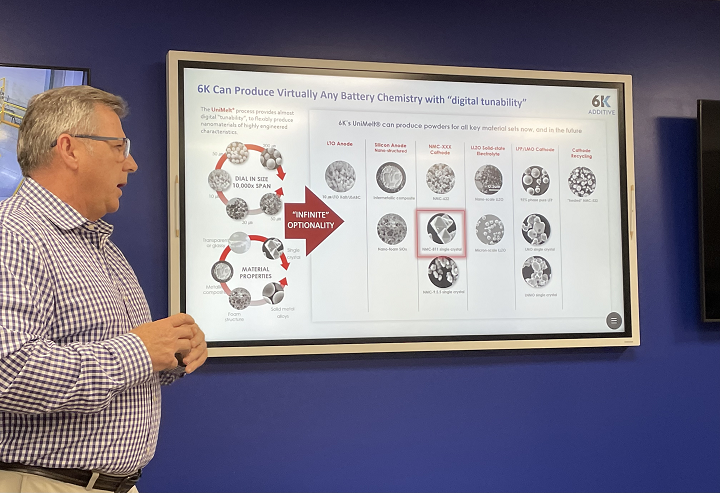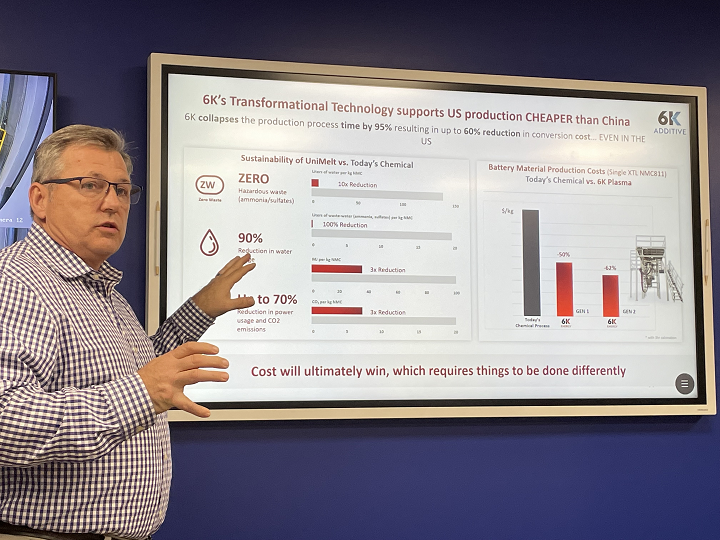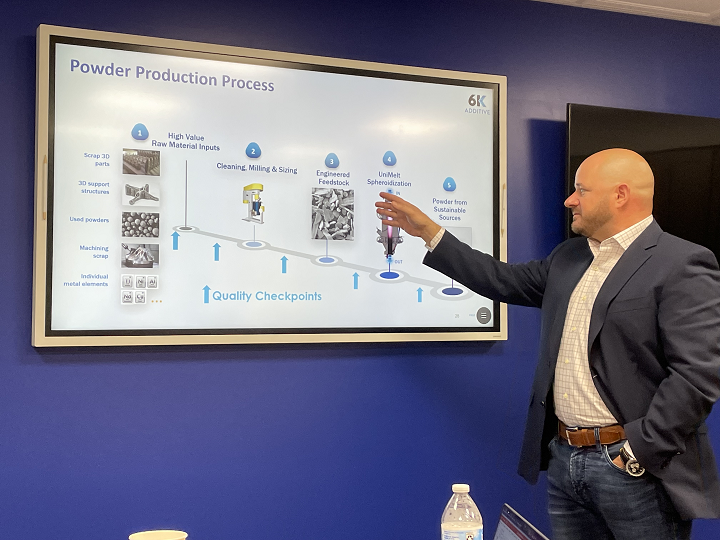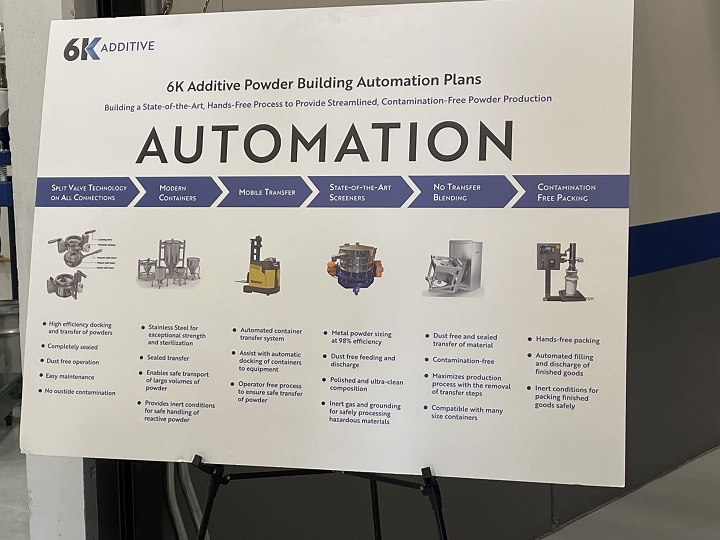6K Inc. produces high-quality, sustainable materials for customers in demanding industries, like aerospace, automotive, consumer electronics, renewable energy, and more. Its proprietary UniMelt microwave plasma production system produces these unique powders for additive manufacturing (AM) and battery materials, and while I’ve had the technology explained to me before, and even seen the results on a small scale, there’s nothing quite like standing right in front of the UniMelt itself. That’s just what I had the chance to do in Burgettstown, Pennsylvania last week, where the company’s 6K Additive production facility is located.
As Bruce Bradshaw, Chief Marketing Officer for 6K, explained to myself and a few other assembled industry journalists and customers, the division never had the chance to hold a formal grand opening of the facility in 2020 due to COVID. In fact, it’s already outgrown the space, which is why 6K Additive just announced that it is now doubling its powder manufacturing capacity.
 6K Additive’s Burgettstown, PA facility
6K Additive’s Burgettstown, PA facility20,000 square feet will be added to accommodate four new UniMelt systems, and 6K Additive is also building a 15,000 square foot feedstock preparation facility on its existing 45-acre campus. Up to 35 new employees will be hired, who, along with the new capacity, will help the company meet the continually growing needs of its customers for titanium, nickel, and refractory powder materials.
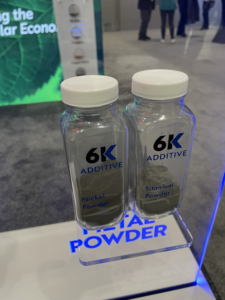 6K’s metal powder at IMTS 2022
6K’s metal powder at IMTS 2022The plant in its current state houses four UniMelt systems, which produce a range of powders, including stainless steel, copper, titanium 64, and nickel alloys, and also has the capability to produce aluminum alloys. Two UniMelts are also co-located at 6K headquarters in North Andover, Massachusetts, which produce rhenium, tungsten, and niobium alloys for defense, rocket, and hypersonic applications. By adding the new facility to its current location, 6K Additive will be better equipped to streamline its operations, enable control and quality of its powder, and provide faster delivery.
6K Process & Sustainability
Before we got the tour, Bradshaw took us through the highlights of 6K, which employs about 170 people across its three divisions, including 6K Energy. 6K has 181 active patents across its product portfolio, and in addition to its corporate headquarters, the company’s battery Center of Excellence is also located in Boston. It’s raised millions through multiple funding rounds and grants from the Department of Defense, the Department of Energy, and the State of Massachusetts.
Bradshaw also discussed 6K Energy, which is focused on producing sustainable, low-cost, and domestically produced battery material, but is about two years behind 6K Additive in terms of commercialization. Today, 85% of the world’s battery materials come from China, while the EU produces 4%. None come from the US.
“We always talk about battery material as being the new oil,” he said. “We have the same technology, and no new way to recover oil or produce gas, so we’re beholden to OPEC. Any time there’s a fluctuation in gas prices, it’s because of our disadvantages. If we don’t take a leapfrog technology and do something different, it’ll be the same situation in batteries. If we just copy China, we’ll establish a domestic cathode capability that will never be competitive. So, what do we do? Change the game.”
The UniMelt process can produce “virtually any battery chemistry with digital tunability.” Testing the chemistry does take a few years, but Bradshaw says 6K is getting “consistently positive” testing feedback, so discussions with several customers are getting ready to progress to the next level.
Additionally, Bradshaw said 6K’s technology can cut the production process time by a whopping 95%, which results in a 60% conversion cost reduction compared to what China’s offering. Sustainability is important, but in the business world, cost is ultimately the name of the game, so the fact that 6K can offer high sustainability at a low cost is a big deal. It’s also important to “ensure a stable, secure source of domestic feedstock in the US.” That’s why 6K’s goals are to have 25% of the material they ship come from domestic sources, and to establish at least two sources of virgin materials for all main components.
6K’s Additive and Energy divisions are “joined at the hip,” with plenty of technology collaboration going on between them. As 6K Additive’s President Frank Roberts told us, “There will be more crossover as the automotive industry continues to adopt additive manufacturing.”
Roberts said 6K Additive is working to expand in titanium, as there’s “huge growth opportunity” there, but the overall goal is to move faster. The current facility has annual capacity for 300 metric tons of powder, but more is still needed.
“We’ve got four reactors up and running, but we need more ASAP,” he said. “So the priority for this year is laying the foundation to then do meaningful site work in the first half of next year, and get those six additional bays and four additional units.”
6K Additive started with just 20 employees, and has about 70 now, with plans to employ around 20 more by the end of 2022. It’s helpful to be located so close to universities, as they’ve been able to hire plenty of engineers, in addition to metallurgists and other people with “dedicated powder experience.”
Roberts reminded us all of the basic UniMelt process: 6K Additive receives high-value raw scrap material (which would otherwise be hazardous waste), then cleans, mills, and dries it to turn it into engineered feedstock. Then, the resulting material is shipped to customers and used to 3D print strong, high-density parts. Derived from MIT research, the proprietary microwave plasma process uses highly uniform temperatures to inject the feedstock, resulting in high spheroidization, while still maintaining precise chemistry control and cleanliness.
“No matter how the ugly the material looks going in, it comes out as a perfect sphere by the end,” Roberts said. “We only put in the reactor what we want to get out, in terms of size…all the energy you’re putting in, you’re getting a lot more usable powder out of it.”
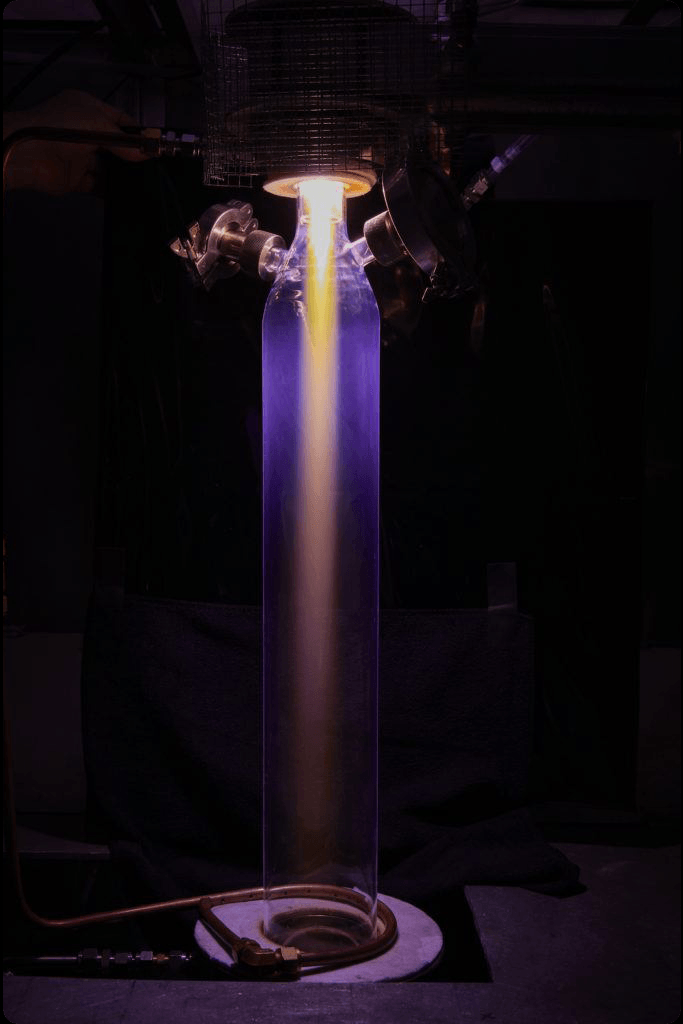 6K’s UniMelt additive metal. Image courtesy of 6K.
6K’s UniMelt additive metal. Image courtesy of 6K.6K also has the numbers to back up its “really green” technology. Just months ago, the company released the results of an independent lifecycle assessment (LCA) by Foresight Management, which compared the environmental impact of the UniMelt process to current atomization technologies being used to produce metal powders. The LCA found a 91% reduction in energy use, and a 92% reduction in carbon emissions when using 6K’s process.
“The equipment manufacturers are paying attention now,” he said, noting that 6K is having active conversations with several major AM companies. “Our MO here is ‘use everything.’ Manage your waste streams by upcycling scrap in order to serve additive and subtractive industries. Our goal is to turn it into premium powder. If the quality isn’t good enough, it’ll flow towards our alloy or powder business. The goal is use everything, and always work to add value.”
Touring 6K Additive’s Facility
Our tour was led by 6K Additive COO Eric Martin, who said safety was not just a priority for the company, but a core value. In alignment with this is a “high focus on automation,” as the milling and pressing operations are operated remotely and independently. The warehouse is subject to regular third party audits, and there were plenty of other safety features, including gas and fire detection in the isolated bays, sensors, process lighting, and more. The facility is so safe, we didn’t even need PPE to walk through.
The facility is also ISO 9001 certified, and 6K is targeting Q1 of 2023 for AS9100 certification, and Q2 of 2023 for ISO 13485. Additionally, the company is working with ASTM International on powder safety handling standards.
With the site expansion, the plan is to double its UniMelt bays, expand the alloy warehouse, machine control, and gas control centers, and add an alloy pavilion and an employee pavilion. A road will also be built from the current building to an adjacent property, which is where the Powder Revert Evaluation Plant, or PREP, will be located.
 6K Additive’s proposed powder building expansion. Images courtesy 6K Additive.
6K Additive’s proposed powder building expansion. Images courtesy 6K Additive.The warehouse was filled with containers of used materials and used jet engine parts sent in by partners to be recycled and turned into metal powder for 3D printing. Martin explained that while UniMelt is 6K’s most technologically advanced method, the decision-making process about which of these parts to break down with the UniMelt and which have to be melted down is actually even more complicated.
Walking outside to the alloys building, we could see the area where the finished pucks are collected. 6K Additive typically receives drums of metal swarf—pieces of debris from subtractive manufacturing processes—in a wet state, which are then opened and loaded into the mill. This is where the materials are sized and cleaned into a slurry, before being automatically fed out and into the presses.
Through the proprietary process, the feedstock is spheroidized and pressed into a puck of contamination-free, high-quality powder, with 25% of the moisture squeezed out; Martin said the water goes into 6K Additive’s own wastewater facility to be cleaned, and is often reused as process water. Then, conveyor belts transport barrels of the compacted materials to the drying machines, after which the pucks are packaged into sleeves for shipping.
The powder production warehouse stores finished goods, separated by reactive and non-reactive materials. Martin said 6K Additive is working towards a goal of no stray, or “fugitive,” powder in the atmosphere, and that phase two of the expansion will entail automating the feeding and collection of powder by the end of next year. Phase three, which is expected to be completed by 2024, is a lights-out facility with fully automated transfers.
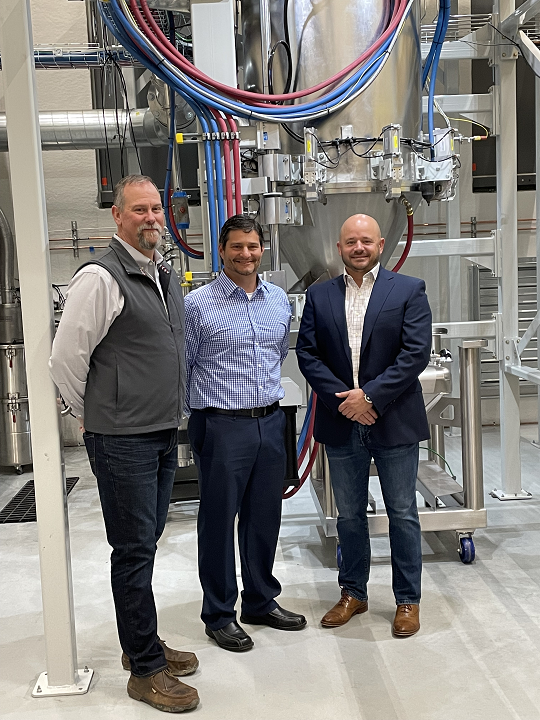 L-R: 6K Additive’s Eric Martin, Jamie Perozzi, and Frank Roberts in front of the UniMelt
L-R: 6K Additive’s Eric Martin, Jamie Perozzi, and Frank Roberts in front of the UniMeltThis warehouse is also where the UniMelt systems are located, each remotely operated in its own bay with blast-rated doors. The gas is isolated and remotely fed into the reactors, and waveguides are carried in through metal tubing. The only moving parts are in the feed hoppers with load cells, which carry the powder into the reactor. The lids can be moved so the reactors, hoppers, and systems can be easily cleaned in order to switch out materials.
As Martin said, the “magic happens at the top” of the UniMelt, about 20 feet up, as that’s where the material is actually loaded. The four systems have a current capacity of 24/7 operation, and units five and six are estimated to be installed in Q2 23, with seven and eight coming in Q3 23. We were allowed to climb up to the top of the deck, and while we couldn’t take any pictures from up there, take it from me that the view was pretty impressive.
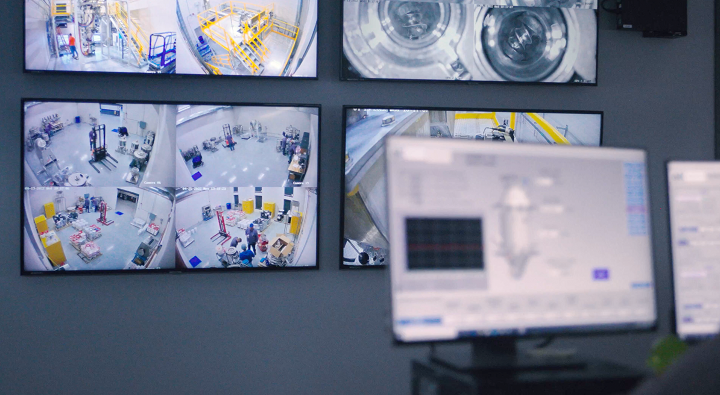 6K Additive Control Room. Image courtesy of 6K Additive.
6K Additive Control Room. Image courtesy of 6K Additive.The last part of the tour took us through the second floor control center, which is the “brains of the operations.” Human operators are remotely monitoring all of the processes, with full visibility of the operation at all times.
Cumberland Additive
After the facility tour and a delicious lunch, there were presentations from two 6K customers. First up was Mark Straszheim, Advanced Materials Lead at 3D printing bureau Cumberland Additive. The company began working with additive in 2006 as Directed Manufacturing Inc., moving from California to Texas in 2009, before it was acquired by RTI Metals in 2014. The next year, RTI was purchased by aluminum company Alcoa, which split into two and made Directed part of Arconic. Private investors purchased Arconic in 2019, and thus Cumberland Additive was born.
Last year, it expanded to the Neighborhood 91 (N91) 3D printing campus at Pittsburgh International Airport, the unique collection of like-minded additive manufacturing businesses that are working to “create enormous efficiencies” in the AM sector. All of the necessary AM components exist within a two-hour radius of Pittsburgh, which is helpful for Cumberland Additive, as it supports customers with visual and functional prototyping, and customized and series production of metal and plastic 3D printed parts and components. In addition to laser beam melting and electron beam melting, the company also uses lathes, CNC machining, EDM machines, metallography equipment, and more.
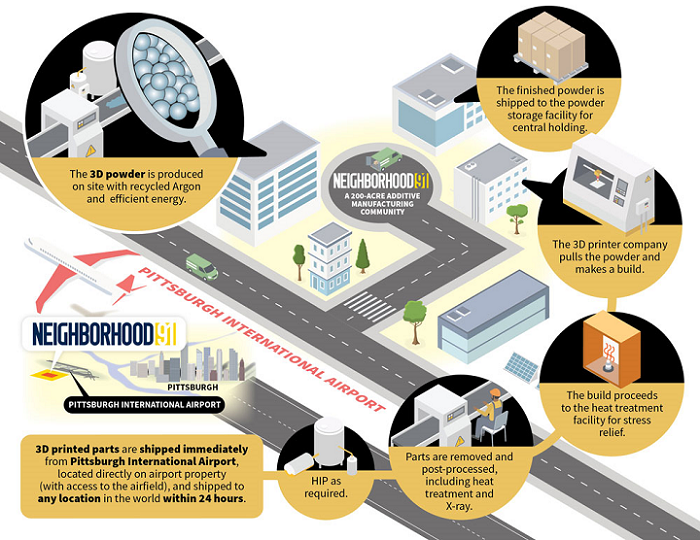 Neighborhood 91 is the first site in the world to contain every element of the AM supply chain, from design to production and distribution. Graphic by The Barnes Group Advisors.
Neighborhood 91 is the first site in the world to contain every element of the AM supply chain, from design to production and distribution. Graphic by The Barnes Group Advisors.Cumberland Additive’s partnership with 6K to get recycled materials is “relatively new,” so there’s room for growth. Straszheim said that refractory methods for additive manufacturing is a great idea, and Bradshaw chimed in, explaining that when competitors experiment with this, 70-80% ends up being thrown away, because of the yield. So it’s a great opportunity for 6K, and Cumberland Additive seems like it’s game. Because it’s focused on deep understanding of potential customers, the company is currently focusing on just a few specific industries, including aerospace and defense, space, and oil & gas.
Quadrus Advanced Manufacturing
Joe Sims is the Director of Quadrus Advanced Manufacturing, a wholly owned subsidiary of Alabama-based Quadrus Corporation, which focuses on rocket technology. As Sims explained, “we are rocket propulsion engineers looking to adopt additive.” Its main focus is applying advanced manufacturing and materials to solid and liquid rocket propulsion, and metal 3D printing has been an integral part of the company’s technology demonstration activities since 2014. Sims said adoption of AM has “accelerated tremendously,” and that Quadrus Advanced Manufacturing is seeing additive opportunities for limited production opportunities with some of its applications by 2024.
Quadrus Advanced Manufacturing exclusively uses laser cusing SLM systems by GE Additive’s Concept Laser, and materials including 316L and 17-4 PH stainless steel, 7A77 aluminum, Ti-64I-4V, Scalmalloy, and more. The important question is what materials are compatible with the AM process the company uses, which is where 6K comes in.
Sims explained that the refractory metal tungsten rhenium is “one of the primary reasons we’re here in additive,” as it’s great for applications that require extreme temperatures, such as nuclear power, rocket propulsion, and hypersonic vehicles. It also has one of the highest melting points of a metallic metal, is weldable, and highly resistant to thermal shock, but there are limited machining approaches and traditional manufacturing methods that can work well with this material. SLM technology can produce highly complex geometries with this material, but generally requires spherical powder. Additionally, because tungsten rhenium is one of the most expensive raw materials, material waste is “not trivial.”
“There’s no room for error, and it all starts with the powder,” Sims said.
“These applications and geometries are not possible without the high-quality, spheroidized powder supplied by 6K.”
Quality, Performance, & New Materials
Jamie Perozzi, 6K Additive’s VP of Technology, closed out the day discussing quality, telling us that the UniMelt technology “also creates a very controlled process, which means creating a consistent product.”
“If you look at our system, it looks a lot like an atomization chamber, but that’s where the similarities end. What happens inside is a lot different, which is why we call it a reactor. We can manipulate a lot more inside than others can.”
He reiterated what Martin had said before about the UniMelt being the company’s “highest level of technical equipment,” but that the most technical part of the process is at the front end in getting materials to create its engineered feedstock. Perozzi said the company also has a lot of control here because of its level of expertise and relationships.
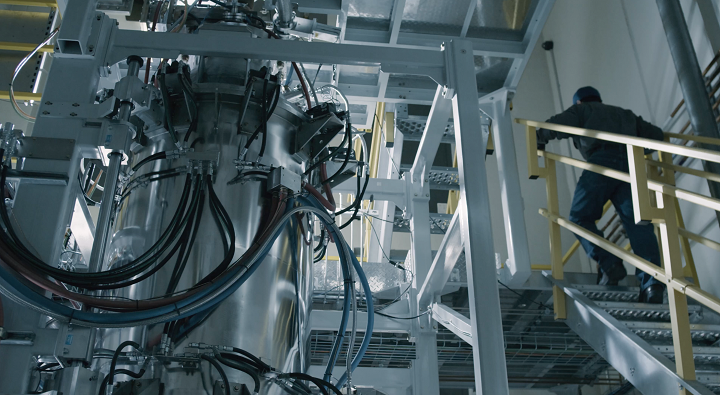 Image courtesy of 6K Additive.
Image courtesy of 6K Additive.“6K can tune powder for 100% production yield, versus the legacy technology that creates an uncontrolled particle size distribution with less than 30% yield,” he continued. “I still have to put focus and control into all the stuff I don’t want. Sometimes the best yielding atomization setup doesn’t give you the best quality. We don’t have to worry about that, because we’re only putting in what we want to get out, which helps us focus on the prime product.”
If you didn’t catch that, I’ll write it again. Perozzi told us that 6K Additive’s sustainable UniMelt process is able to achieve 100% usable powder, with consistent performance across its range of alloy families. The company has the data to back up what it’s saying, and I’m excited to see where it goes next.
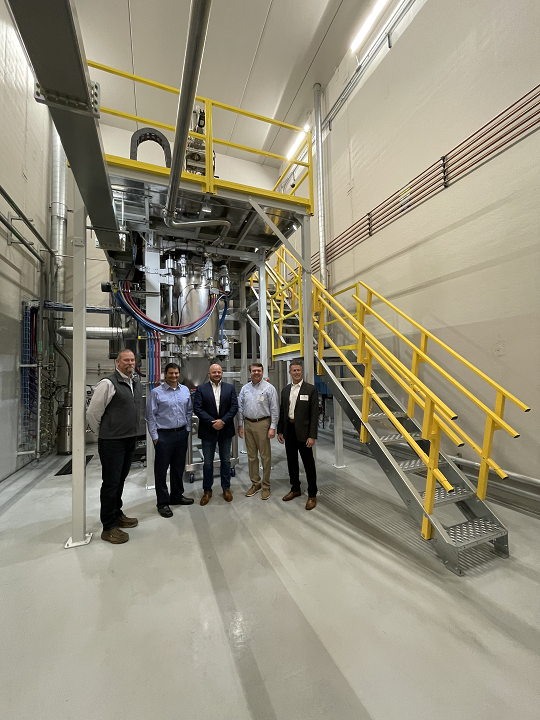 6K’s Martin, Perozzi, and Roberts are joined by Joe Simms, Quadrus, and Mark, Cumberland Additive
6K’s Martin, Perozzi, and Roberts are joined by Joe Simms, Quadrus, and Mark, Cumberland AdditiveFeatured image courtesy of 6K Additive. All other images by Sarah Saunders for 3DPrint.com, unless otherwise noted.
Subscribe to Our Email Newsletter
Stay up-to-date on all the latest news from the 3D printing industry and receive information and offers from third party vendors.
You May Also Like
3D Printing Financials: Fathom Struggles in Financial Quicksand During Critical Transition
Facing a year of key transitions and financial pressures, Fathom (Nasdaq: FTHM) has filed its annual report for 2023 with the U.S. Securities and Exchange Commission (SEC). The document outlines...
Latest Earnings Overview for Australian 3D Printing Firms Titomic and AML3D
Australian 3D printing manufacturing firms Titomic (ASX: TTT) and AML3D (ASX: AL3) reported their financial results for the period from July to December 2023, marking the first half of their...
3D Printing Webinar and Event Roundup: April 7, 2024
Webinars and events in the 3D printing industry are picking back up this week! Sea-Air-Space is coming to Maryland, and SAE International is sponsoring a 3D Systems webinar about 3D...
3D Printing Financials: Unpacking Farsoon and BLT’s 2023 Performance
In the Chinese 3D printing industry, two companies, Farsoon (SHA: 688433) and Bright Laser Technologies, or BLT (SHA: 688333), have recently unveiled their full-year earnings for 2023. Farsoon reported increases...


